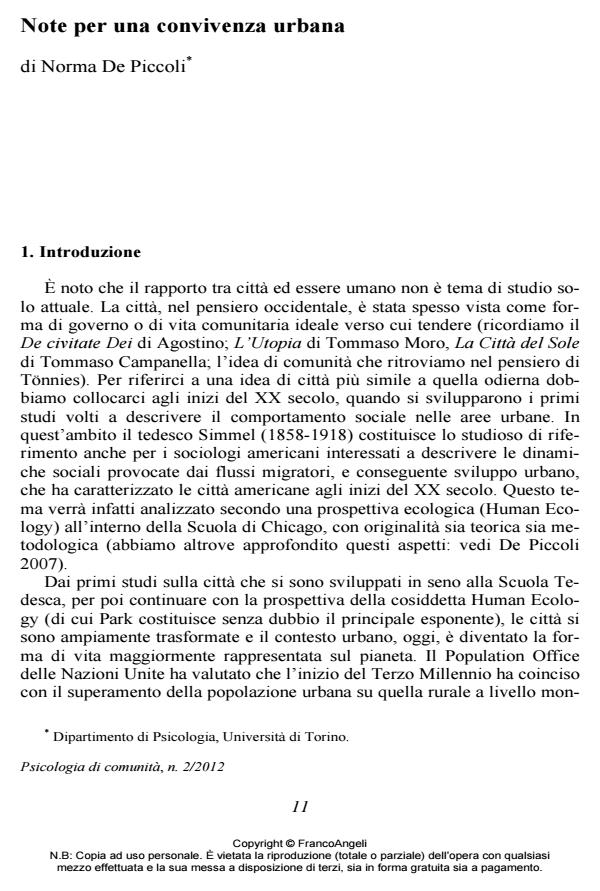Note per una convivenza urbana
Journal title PSICOLOGIA DI COMUNITA’
Author/s Norma De Piccoli
Publishing Year 2013 Issue 2012/2 Language Italian
Pages 11 P. 11-21 File size 245 KB
DOI 10.3280/PSC2012-002002
DOI is like a bar code for intellectual property: to have more infomation
click here
Below, you can see the article first page
If you want to buy this article in PDF format, you can do it, following the instructions to buy download credits

FrancoAngeli is member of Publishers International Linking Association, Inc (PILA), a not-for-profit association which run the CrossRef service enabling links to and from online scholarly content.
The article presents a brief psychosocial analysis on the city, specifying the characteristics of the current urban setting. An analysis both of the Italian housing situation, with specific reference to the last decades, and of urban regeneration that have been made will follow. The recent urban interventions are of particular interest because they aimed (and aim) to improve the quality of life in residential contexts favoring the social mix and the development of social networks through direct forms of participation. These issues are here briefly presented in reference to the critical elements that must be considered, and possibly prevent, in the interventions design.
Keywords: Living social, city, urban regeneration, participation, social housing.
- Amerio P. (2004). Problemi umani in comunità di massa. Torino: Einaudi
- Ciaffi D., Mela A. (2011). Urbanistica partecipata. Modelli ed esperienze. Roma: Carocci editore
- Cittalia, Fondazione ANCI Ricerche (2010). L’abitare sociale. Strategie locali di lotta alla povertà: città a confronto. Associazione Nazionale Comuni Italiani
- Cleaver F. (2004). Institutions, Agency and the Limitations of Participation Approaches to Development. In: B. Cooke, U. Kothari (eds.), Participation. The new tyranny?. London: Zed Books, pp. 36-55.
- Commissione Governo delle Città del Consiglio Italiano per le Scienze Sociali (2011). Libro bianco sul governo delle città italiane. In: G. Dematteis, op. cit., pp. 379-424
- Dematteis G. (a cura di) (2011). Le grandi città italiane. Venezia: Marsilio editore
- De Piccoli N. (2007). Individui e contesti in psicologia di comunità. Milano: Unicopli
- Donolo C. (2011). Sul governo possibile delle città. In: G. Dematteis, op. cit., pp. 175-206
- Gasparini A. (2000). La sociologia degli spazi. Roma: Carocci
- Governa F., Saccomani S. (2009). Housing and Urban Regeneration Experiences and Critical Remarks Dealing with Turin. International Journal of Housing Policy, 9 (4): 391-410
- Jacobs J. (1961). The Death and Life of Great American Cities. New York: Vintage (Vita e morte delle grandi città. Saggi sulle metropolis americane. Torino: Giulio Einaudi, 1969).
- Krupat E., Guild W. (1980). Defining the City: The Use of Objective and Subjective Measures for Community Description. Journal of Social Issues, 36 (3): 9- 28.
- Lannutti C. (2011). Tecnologie e processi di riqualificazione dell’ediliza residenziale pubblica. Ponte, 10: 24-27
- Lees L. (2008). Gentrification and social mixing: towards an inclusive urban renaissance? Urban Studies, 45 (2): 2449-2470
- Martinotti G. (2011). Dalla metropoli alla meta-città. Le trasformazioni urbane al tornante del secolo XXI. In: G. Dematteis G., op. cit., pp. 25-76.
- Mumford L. (1966). The Culture of Cities. San Diego: Harcourt Brace & Company (tr. it., 1999, La cultura della città. Torino: Edizioni di Comunità).
- Musterd S. (2008). Residents’ views on social mix: social mix, social networks and stigmatization in post-war housing estates in Europe. Urban Studies, 45 (4): 897-915
- Wallerstein N. (2006). What is the evidence on effectiveness of empowerment to improve health? Copenaghen: WHO Regional Office for Europe
Norma De Piccoli, Note per una convivenza urbana in "PSICOLOGIA DI COMUNITA’" 2/2012, pp 11-21, DOI: 10.3280/PSC2012-002002